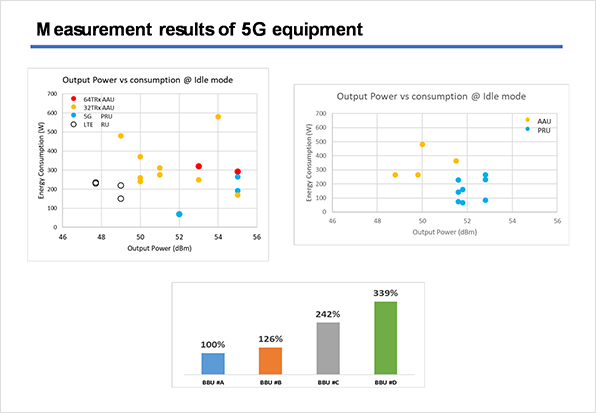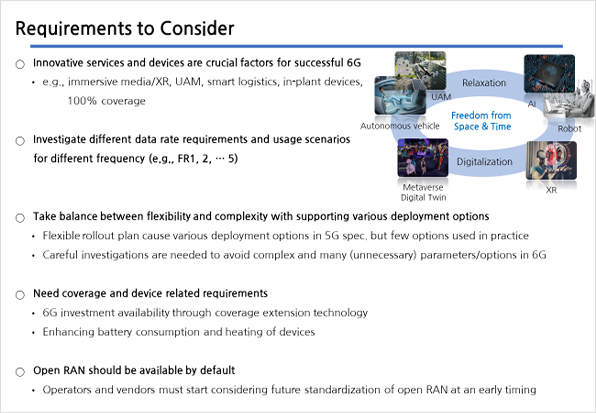NTT DOCOMO & SK Telecom Release White Papers on Energy Efficient 5G Mobile Networks and 6G Requirements
- Possibilities to achieve greater energy savings based on energy consumption levels measured in the two companies’ respective base stations
- Technical analysis of candidate energy-saving technologies, including both hardware and software
- The roles that operators and equipment vendors should play, including the need for greater coordination, in the effort to achieve greater energy savings

For 6G, the paper reviews requirements and challenges including specific performance levels and implementation scenarios, focusing on technical issues of particular importance to mobile operators:
- Performance requirements and implementation scenarios for each frequency band, taking into account the characteristics of each frequency
- Issues concerning coverage and devices in high-frequency bands
- Standardization for migration to 6G architecture and application of cloud-native / open architecture

Going forward, NTT DOCOMO and SKT will continue to collaborate in various technical fields, aiming to enhance the competitiveness and operational efficiency of 5G as well as support the global standardization and technical verification of 6G. They will also collaborate with global telecom operators on 6G standardization and R&D with the goal of building a global ecosystem that encompasses advanced industries and technologies.
“The white papers carry a significant meaning as they mark the first tangible result since entering into a strategic partnership with NTT DOCOMO last year,” said Yu Takki, Vice President and Head of Infra Tech Office of SKT. “Based on our experience and knowhow in 5G, we will continue to collaborate with world-leading operators such as NTT DOCOMO to lead 5G evolution towards 6G.”
Takehiro Nakamura, Chief Technology Architect, NTT DOCOMO, said: “We are delighted to jointly announce two white papers on green mobile networks and 6G requirements as our collaborative achievements with SKT started in November 2022. We will continue to enhance cooperation among the two major Asian mobile operators and promote superior concepts and innovative technologies to the world for the 6G deployment.”
3 thoughts on “NTT DOCOMO & SK Telecom Release White Papers on Energy Efficient 5G Mobile Networks and 6G Requirements”
Comments are closed.



Ericsson reviewed various seminal 6G white papers across wireless industries, regional research partnerships and academia to give you the nine key takeaways from the 6G early research phase.
1. Sustainability goals will be crucial to 6G use case development
2. 6G will deliver extreme performance
3. 6G networks will offer sensing capabilities
4. 6G will support trillions of embeddable devices
5. Network resilience will be a key design element of 6G systems
6. 6G network architecture will be more adaptable and dynamic
https://www.ericsson.com/en/blog/2023/2/6g-early-research-global-takeaways
Another Opinion on 6G:
6G is the upcoming sixth-generation cellular network technology that is currently in early development. One of the goals of 6G cellular technology is not just to deliver basic content faster to smartphones, like streaming video, but to create a cellular network capable of supporting real-time augmented reality, virtual reality, and a future Internet of Things (IoT) model where small smart devices are a ubiquitous presence in and outside of our homes.
When reading anything about 6G, especially the breathless and hype-laden announcements from telecommunications companies that emphasize how 6G will usher in the metaverse, a fusion of our physical and virtual lives, and so on, you should keep the “early” part of early development in mind.
Currently, there are no established 6G specifications or standards, let alone deployed 6G networks or devices. Even the most basic aspects of 6G development, like which specific frequencies the next generation cellular technology will rely on, are still being ironed out along with technical challenges like energy and heat dissipation demands of advanced 6G devices.
That said, we do have some idea what 6G will look like. Current cellular technology operates in the Megahertz (MHz) and the lower Gigahertz (GHz) frequency ranges. The portion of the radio spectrum under consideration and testing for 6G includes frequencies in the 30-300 Ghz range—also known as millimeter waves (mmWave) or Extremely High Frequency (EHF) radio—and the Terahertz (THz) frequency up to 3000 Ghz. The use of these frequencies will allow for data transmission well beyond the bandwidth capacity of current cellular technology.
In December of 2022, Qualcomm released a 6G development plan with 2030 as a projected rollout date for 6G tech. Ericsson’s 6G messaging echoes the early 2030s timeframe too, as do various interviews with telecom executives.
5G was first introduced in 2019. Four years later, there are still millions of cellular subscribers using 4G, and 5G is yet to have a fully realized coast-to-coast rollout. GSMA’s authoritative 2023 Mobile Economy report, for instance, indicates North American adoption rate of 5G is only 39%, with more than half of cellular subscribers still using 4G. By their projections, the North American 5G adoption rate will be 91% by 2030, meaning by the time 6G potentially arrives, there will still be 4G subscribers out there.
Given the current development timelines, you should expect a delivery arc similar to the 5G rollout. If you live in a major metropolitan area, there is a good chance you’ll be covered by early 6G networks around 2030. If you’re not in a major metropolitan area, it’s likely you’ll be waiting well into the 2030s for the 6G rollout.
So if we step away from the hype and look at the matter practically, it’s likely only a small percentage of people will be using 6G-based networks by 2030. But the bulk of North American subscribers, and certainly the majority of global subscribers, will still be on 5G networks.
Nokia just opened a 6G lab in Bangalore, India which is a joke since 6G specs from 3GPP and standards from ITU-R won’t be completed until 2030-2031. So what can be tested or prototyped at that 6G lab or any of the others launched this year?